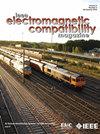无人机数据链电磁干扰影响评估
IF 2.5
3区 计算机科学
Q3 ENGINEERING, ELECTRICAL & ELECTRONIC
IEEE Transactions on Electromagnetic Compatibility
Pub Date : 2025-04-11
DOI:10.1109/TEMC.2025.3550620
引用次数: 0
摘要
为了评估无人机在复杂电磁环境下的生存能力,提出了一种评估无人机电磁干扰威胁的新方法。通过电磁干扰注入测试,生成了无人机数据链的失锁阈值数据集。然后应用遗传算法(GA)优化的极端梯度增强(XGBoost)来有效地预测这些锁丢失阈值。并采用Shapley加性解释(SHAP)来衡量特征的重要性。与k近邻、支持向量机、决策树和XGBoost相比,GA-XGBoost具有更好的预测精度和整体性能。在此基础上,提出了基于ga - xgboost的电磁干扰效应评价方法,利用三级效应指标将电磁干扰效应划分为四级。最后,利用电磁干扰效应水平和SHAP结果制定有针对性的抗干扰策略。该方法有助于提高无人机的抗干扰性能。本文章由计算机程序翻译,如有差异,请以英文原文为准。
Assessment of EMI Effects on UAV Data Links
To assess the survivability of an unmanned aerial vehicle (UAV) in a complex electromagnetic environment, a novel method for assessing electromagnetic interference (EMI) threats to a UAV is introduced. A dataset of loss-of-lock thresholds for the UAV data link was generated through EMI injection tests. A genetic algorithm (GA)-optimized extreme gradient boosting (XGBoost) was then applied to efficiently predict these loss-of-lock thresholds. And Shapley additive explanations (SHAP) were used to measure the importance of features. Compared with K-nearest neighbor, support vector machine, decision tree, and XGBoost, GA-XGBoost shows better prediction accuracy and overall performance. Based on this, a GA-XGBoost-based assessment method was proposed to classify EMI effects into four levels using a three-level effect index. Finally, the EMI effect levels and SHAP results were used to formulate targeted anti-interference strategies. The proposed method can help to improve the anti-interference performance of UAVs.
求助全文
通过发布文献求助,成功后即可免费获取论文全文。
去求助
来源期刊
CiteScore
4.80
自引率
19.00%
发文量
235
审稿时长
2.3 months
期刊介绍:
IEEE Transactions on Electromagnetic Compatibility publishes original and significant contributions related to all disciplines of electromagnetic compatibility (EMC) and relevant methods to predict, assess and prevent electromagnetic interference (EMI) and increase device/product immunity. The scope of the publication includes, but is not limited to Electromagnetic Environments; Interference Control; EMC and EMI Modeling; High Power Electromagnetics; EMC Standards, Methods of EMC Measurements; Computational Electromagnetics and Signal and Power Integrity, as applied or directly related to Electromagnetic Compatibility problems; Transmission Lines; Electrostatic Discharge and Lightning Effects; EMC in Wireless and Optical Technologies; EMC in Printed Circuit Board and System Design.

 求助内容:
求助内容: 应助结果提醒方式:
应助结果提醒方式:


